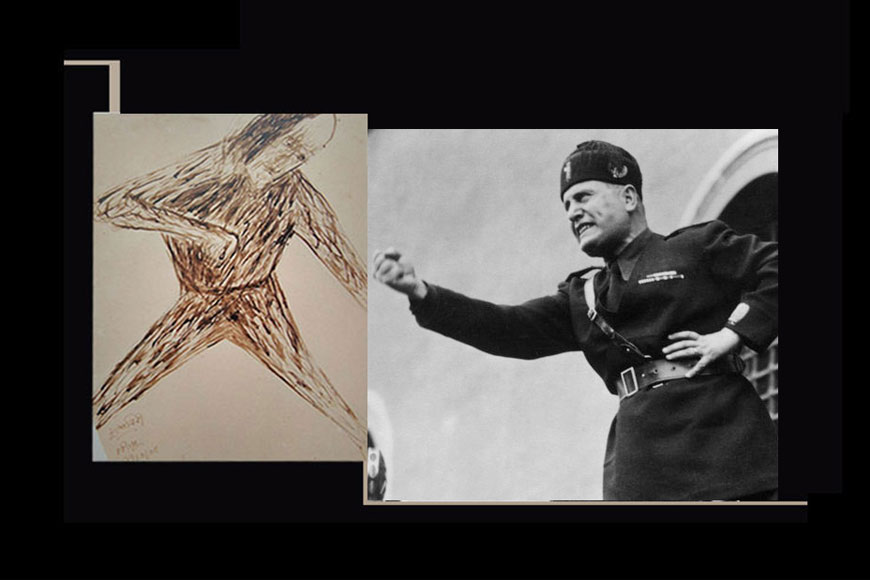Why did Rabindranath Tagore draw a portrait of fascist Mussolini!

March 17, 1935. A peace-loving great humanist and poet-artist sketched the profile of hated tyrant-dictator, Benito Mussolini – one who is held as the mastermind behind World War II. But who was the artist? None other than Rabindranath Tagore. The lines that depict the portrait have a queer movement --- they are edgy, turbulent and frenzied. Prior to this, Tagore had never attempted to draw portraits of well-known public figures. The profile he drew was not particularly akin to Mussolini, yet, Tagore specifically identified and mentioned Mussolini’s name below the portrait. Why Mussolini?
In 1925,Italian academicians Carlo Formichiand Guiseppe Tucci came to Santiniketan as teachers. They broughta generous gift of books for Visva Bharati University library, sent by Mussolini. The Italian government also offered Tucci’s services for free at Visva Bharati as all his expenses would be paid by Mussolini’s government. Tagore was very impressed at this gesture. He personally sent a telegram to Mussolini and thanked him profusely for his contribution. Meanwhile, Formichisinuously canvassed Mussolini’s love and admiration for India. This was all part of a well-orchestrated plot and Tagore became a mere pawn in Mussolini’s heinous ploy.
Tagore was next invited to visit Italy by Mussolini and the poet, unaware of the dictator’s plan, accepted the invitation in good faith. He spent a fortnight in Italy as a guest of the Italian government. The Italian government gave a royal reception to Tagore and his entourage, and the poet was overwhelmed.Mussolini ordered a reception in his honour at the Colloseumof Rome. The event was attended by almost 30,000 people. The poet was moved. He wished to meet renowned Italian philosopher Benedetto Croce. Mussolini granted permission. The poet was unaware that Croce was under house arrest for criticizing Mussolini’s regime.
Next, the poet went to visit Villeneuve village. He stayed in an upmarket hotel there. The room which was allotted to him was previously occupied by Victor Hugo. The poet was overwhelmed. He began praising Mussolini. His praise for Mussolini was reported in the Italian press with exuberance. As Tagore did not know the language, he did not realise that his speeches and interviews were distorted in favour of Mussolini and his regime.Everything was working according to Mussolini’s diabolic plan. The dictator’s international image in those years was an all-time low and he wanted to divert global attention by inviting Tagore to Italy, expecting his praise for his fascist government would give him popularity.
The European press was baffled to read the poet’s euphoric praise for Mussolini and his authority. However, after leaving Italy, Tagore realised his mistake. Finally, on August 5, 1926,he wrote a long letter to Father Charles Freer Andrews, explaining the context of his Italian tour and how he had been trapped. The letter was published in The Manchester Guardian. Mussolini and his comrades were furious when they came across the article by Tagore. Immediate steps were taken to recall Tucci from Santiniketan.
Tagore’s sketch of Mussolini portrays an insane dictator. He etched perfectly the war-monger’s excitement in the midst of anarchy. The poet was full of self –reproach for praising Mussolini and supporting fascism which ruthlessly suppresses freedom of expression and enforces observances that are against individual conscience.Ten years after his visit to Italy, Tagore sketched Mussolini’s portrait. It was his way of purifying himself for ‘defilement’ to which he once submitted himself in Italy.









